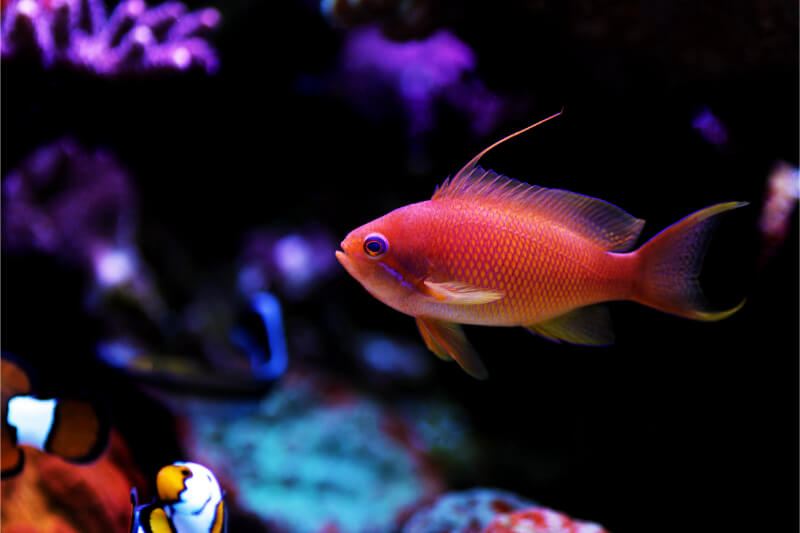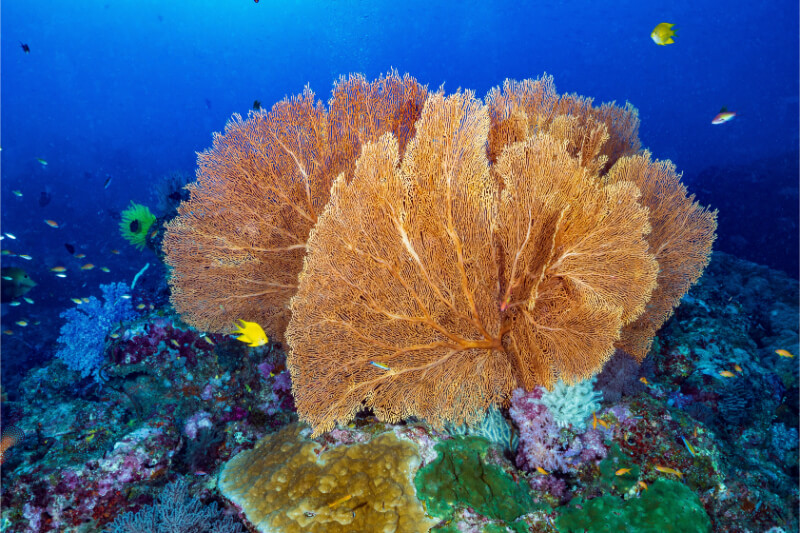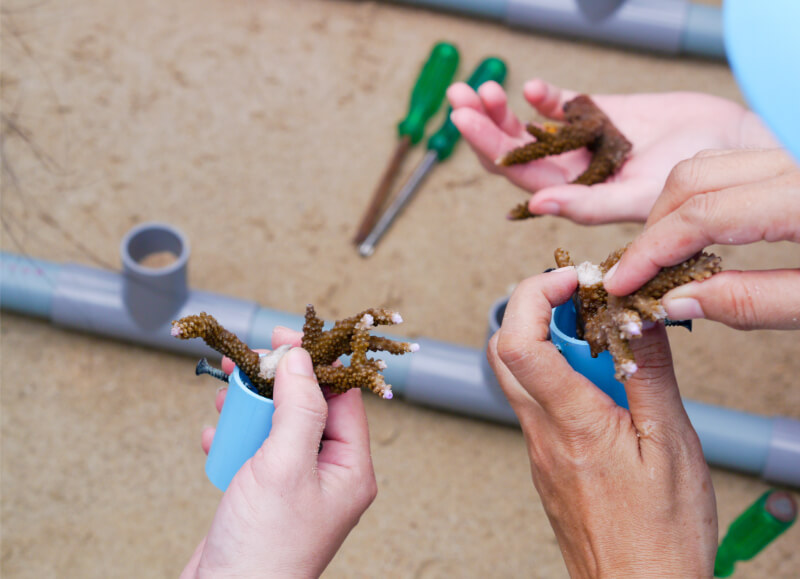Thanks for stopping by to learn about Lyretail Anthias fish. These guys are a great and colorful addition to any saltwater tank.
If you are looking for a hardy fish that can adapt easily to a captive lifestyle, look no further! For any anthias first time owner, the lyretail is a great option especially if reef safety is part of the requirements.
We hope you enjoy reading this guide as much as we enjoyed writing it, let’s begin!
Quick Facts
| Scientific Name: | Pseudanthias squamipinnis |
| Other Names: | orange basslet, lyretail coralfish, onestripe goldie, lyretail anthias, lyretail fairy basslet, orange fairy basslet, orange seaperch, scalefin basslet, scalefin Fairy basslet and scalefin anthias |
| Reef Safe: | Yes |
| Lifespan: | 3 to 5 years |
| Size: | Male: 5-6 inches. Female: 2.5-3 inches. |
| Care: | Medium |
| Diet: | Carnivorous. Mysis shrimp, brine shrimp, copepods, amphipods, high-quality marine flake foods, frozen marine foods |
| Water Parameters: | Temperature: 72-78°F (22-26°C).pH: 8.1-8.4.Salinity: 1.020-1.025 SG.Ammonia and Nitrite: 0 ppm.Nitrates: Below 20 ppm. Water changes:10-15{a47be734f0df8d7f120a7df290cf380c79376e8356d1aab405383bb23aa6ce67} weekly. |
| Tank Size: | 75 gallons for a small group and 125 gallons for larger groups |
| Behavior: | Peaceful with the right tank mates and tank size |
| Breeding Difficulty: | Challenging, not very common. |
Species Summary
Lyretail Anthias or Pseudanthias squamipinnis (scientific name), also known as Sea Goldie, are vibrant fish originating from the Indo-Pacific region from the Red Sea all the way to the Central Pacific. They are known for their striking colors and flowing fins. These social and active fish prefer living in groups and thrive in well-maintained marine aquariums.
Their care level is moderate as long as the water quality, diet and tank mates are watched out for. Since they enjoy regular feedings, you will need to put some effort into keeping the tank clean or be ready to invest in a high quality filtration system. It is not as bad as you think, we are just giving you a heads up.
Lyretail Anthias Lifespan
Lyretail anthias typically have a lifespan between 3 to 5 years in captivity. This lifespan can vary depending on several factors, including water quality, diet, and overall care.
In optimal conditions with proper nutrition and a stress-free environment, some lyretail anthias may reach up to 7 years. However, this is less common and shouldn’t be expected as the norm.
We’ve observed that male lyretail anthias often have slightly shorter lifespans compared to females. This difference is likely due to the increased energy expenditure associated with maintaining their vibrant colors and defending territories.
Appearance
Lyretail anthias display striking colors and sexual dimorphism, with males and females differing significantly in size and appearance. Their vibrant hues and unique fin structures make them popular additions to saltwater aquariums.
Red Lyretail Anthias
Male red lyretail anthias exhibit a stunning orange-red coloration. Their most distinctive feature is the elongated fin rays, particularly in the caudal fin, which creates a lyre-shaped tail. These males can grow up to 6 inches in length, making them considerably larger than their female counterparts.
The dorsal fin of male red lyretails is also elongated, adding to their elegant appearance. Their scales often have a shimmering quality, reflecting light in captivating ways as they swim.
Orange Lyretail Anthias
Female lyretail anthias typically display a more subdued orange-yellow coloration. They are smaller than males, usually reaching a maximum length of about 3 inches. While lacking the elongated fins of males, females still possess a graceful appearance.
Their bodies are more rounded and compact compared to males. Female lyretails often have a pinkish or reddish hue on their fins, which adds a subtle contrast to their predominantly orange-yellow bodies.
Both male and female lyretail anthias have large eyes relative to their body size, which aids in their perception and behavior in the reef environment.
Male vs Female
Lyretail anthias exhibit clear sexual dimorphism. We can observe distinct differences between males and females in both size and coloration.
In groups, there’s usually one dominant male with several females. Interestingly, lyretail anthias are protogynous hermaphrodites (say that ten times fast). This means some females can change sex to become males if needed.
When keeping lyretails in aquariums, it’s important to maintain proper group dynamics. A ratio of one male to several females often works best. This mimics their natural social structure and helps reduce aggression.
Author Note: We recommend careful observation when introducing lyretails to a tank. Males can be territorial, especially in smaller spaces. Providing ample hiding spots and swimming room can help mitigate potential conflicts.
Size
Lyretail anthias exhibit notable sexual dimorphism in size. Males typically grow larger, reaching lengths of 5-6 inches (12.7-15.2 cm). Females, on the other hand, tend to be about half that size, maxing out around 2.5-3 inches (6.4-7.6 cm).
Author Note: It’s worth noting that the size difference between males and females serves a purpose in their social structure. The larger males often dominate harems of smaller females in the wild. In captivity, we suggest keeping one male with several females to mimic this natural grouping.
Lyretail Anthias Care
Lyretail anthias require specific care to thrive in captivity. Proper tank size, setup, and water parameters are crucial for their health and well-being.
Tank Size
Lyretail anthias need a spacious aquarium to accommodate their active swimming behavior. The recommended minimum tank size is 75 gallons for a small group (check our 75-Gallon Fish Tank guide). For larger groups or harems, a 125-gallon tank or larger is ideal.
Author Note: These fish prefer to swim in open water, so providing ample space is essential. A longer tank is better than a taller one, as it allows for more horizontal swimming room.
Tank Setup
The tank setup should mimic the anthias’ natural reef environment. Our suggestion is to incorporate live rock formations to create hiding spots and territories. Arrange the rocks to form caves, overhangs, and swim-throughs.
Add a mix of soft and hard corals to enhance the reef-like atmosphere. Ensure strong water flow throughout the tank, as lyretail anthias are accustomed to currents in their native habitat.
Proper lighting is crucial for both the fish and any corals in the tank. Use high-quality LED or T5 fixtures to provide adequate illumination (check these from Walmart).
Water Parameters
Maintaining stable water parameters is vital for lyretail anthias health.
- Temperature: 72-78°F (22-26°C).
- pH: 8.1-8.4.
- Salinity: 1.020-1.025 SG.
- Ammonia and Nitrite: 0 ppm.
- Nitrates: Below 20 ppm.
- Water changes:10-15{a47be734f0df8d7f120a7df290cf380c79376e8356d1aab405383bb23aa6ce67} weekly.
Strong filtration is essential to handle the bioload of these active fish. We recommend a combination of mechanical, biological, and chemical filtration for optimal results.

Best Food and Diet for a Sea goldie
Lyretail Anthias are carnivorous fish with specific dietary needs. In the wild, they primarily feed on planktonic organisms in the water column.
In aquariums, these fish require a varied diet to thrive. Try offering small, frequent meals throughout the day to mimic their natural feeding habits.
Ideal food options for Lyretail Anthias include:
It’s crucial to provide a mix of these foods to ensure proper nutrition. While some Lyretail Anthias may accept flake foods, they shouldn’t be the sole diet component.
We’ve found that offering food 2-3 times daily helps maintain their health and vibrant colors. Small, meaty meals are preferable to large portions.
Author Note: Supplementing their diet with vitamin-enriched foods can boost their immune system and overall health. This is particularly important for captive-bred specimens.
Behavior and Temperament
Lyretail anthias are highly active and social fish with vibrant personalities. We often observe them swimming energetically around their environment, rarely pausing to rest.
These fish thrive in groups, ideally with at least 10 individuals. Smaller groups of 5-6 can work, but may not be optimal for their social needs.
Lyretail anthias tend to be outgoing and lively. They’re known as the “life of the party” in reef tanks, often encouraging shyer fish species to be more active.
In the wild, lyretail anthias form harems with a dominant male and several females. This social structure influences their behavior in captivity as well.
You will typically find these fish swimming near the top of live rock formations or in open water in front of the reef. Their constant movement adds dynamic energy to any aquarium.
Author Note: Interestingly, lone female lyretail anthias may transition to male if kept without others of their species. This adaptability showcases their complex social behavior.
While generally peaceful, lyretail anthias can be territorial within their own species. Proper group size and tank space help minimize aggressive behaviors.
Tank Mates
Lyretail anthias are generally peaceful fish, making them compatible with a variety of tank mates. We recommend choosing other non-aggressive reef-dwelling species to create a harmonious aquarium environment.
Some suitable tank mates for lyretail anthias include:
It’s important to avoid housing lyretail anthias with larger, predatory fish that might view them as prey. Aggressive species should also be avoided to prevent stress and potential harm to the anthias.
It is advised to introduce lyretail anthias to the tank before other species. This allows them to establish their territory and reduces potential conflicts with new additions.
Author Note: Remember that male lyretail anthias can be territorial, especially towards other males of their species. If keeping multiple males, provide ample space and hiding spots to minimize aggression.
Lastly, consider the feeding habits of potential tank mates. Choose species that won’t outcompete the anthias for food, ensuring all fish receive proper nutrition.
Breeding Tips
Breeding lyretail anthias in captivity is challenging but possible with the right setup and care. Some say the survival rate is about 10{a47be734f0df8d7f120a7df290cf380c79376e8356d1aab405383bb23aa6ce67} which doesn’t look too impressive but if this is done commercially producing thousands of eggs, then the surviving number of fish is quite large.
To start, we recommend a large, dedicated breeding tank of at least 100 gallons to give the fish ample space.
Maintain stable water parameters with a temperature around 76-82°F (24-28°C) and pH between 8.0-8.4. Proper nutrition is crucial for spawning success. Offer a varied diet of small meaty foods like copepods, mysid shrimp, and enriched brine shrimp.
Establish a harem with one male and several females to encourage natural behavior. Provide plenty of live rock and caves for hiding spots and egg-laying sites.
Simulate natural light cycles and lunar phases to trigger spawning. Gradual changes in photoperiod can help induce breeding behavior.
Be prepared to raise tiny, delicate larvae. Have rotifers and other appropriately-sized live foods ready before eggs hatch. Use a separate rearing tank with gentle water movement for the fragile fry.
Patience is key. Successful breeding may take months of conditioning and multiple attempts. Keep detailed records of water parameters, feeding, and any observed spawning activity to refine your approach over time.
Wrapping Up
In conclusion, Lyretail Anthias are a captivating and lively addition to any marine aquarium. With their vibrant colors and dynamic behavior, they bring life and beauty to your tank.
While they require moderate care, including proper water quality, a balanced diet, and a suitable environment, the effort is well worth it. By meeting their needs and providing a peaceful community, you can enjoy the stunning presence of these fish for years to come.
If you enjoyed this guide and are looking for more, take a quick look at our other Saltwater Fish Care Guides. If you have any questions don’t hesitate to reach out to us and feel free to tag us on Facebook when sharing cool photos of your Sea Goldie.
Are Lyretail Anthias aggressive?
Not really unless they are underfed or when kept in cramped conditions (who wouldn’t?) since they could become territorial.
What are some fun facts about anthias?
They live in harems or small groups within large schools led by one large male. The groups have many small females and small males.
How long does it take for Lyretail Anthias to turn male?
In the absence of a dominant male, a dominant female might turn male in about 2 to 3 weeks.




